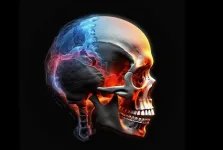(Press-News.org) Craniosynostosis, the premature fusion of the top of the skull in infants, is caused by an abnormal excess of a previously unknown type of bone-forming stem cell, according to a preclinical study led by researchers at Weill Cornell Medicine.
Craniosynostosis arises from one of several possible gene mutations, and occurs in about one in 2,500 babies. By constricting brain growth, it can lead to abnormal brain development if not corrected surgically. In complex cases, multiple surgeries are needed.
In the study, which appears Sept. 20 in Nature, the researchers examined in detail what happens in the skull of mice with one of the most common mutations found in human craniosynostosis. They found that the mutation drives premature skull fusion by inducing the abnormal proliferation of a type of bone-making stem cell—the DDR2+ stem cell—that had never been described before.
“We can now start to think about treating craniosynostosis not just with surgery but also by blocking this abnormal stem cell activity,” said study co-senior author Dr. Matt Greenblatt, an associate professor of pathology and laboratory medicine at Weill Cornell Medicine and a pathologist at NewYork-Presbyterian/Weill Cornell Medical Center.
The other co-senior author of the study was Dr. Shawon Debnath, a research associate in the Greenblatt laboratory.
In a study published in Nature in 2018, Drs. Debnath and Greenblatt and their colleagues, described the discovery of a type of bone-forming stem cell they called the CTSK+ stem cell. Because this type of cell is present in the top of the skull, or “calvarium,” in mice, they suspected that it has a role in causing craniosynostosis.
In the new study, they investigated that possibility by engineering mice in which CTSK+ stem cells lack one of the genes whose loss of function causes craniosynostosis. They expected that the gene deletion somehow would induce these calvarial stem cells to go into bone-making overdrive. This new bone would fuse the flexible, fibrous material called sutures in the skull that normally allow it to expand in infants.
“We were surprised to find that, instead of the mutation in CTSK+ stem cells leading to these stem cells being activated to fuse the bony plates in the skull as we expected, mutations in the CTSK+ stem cells instead led to the depletion of these stem cells at the sutures—and the greater the depletion, the more complete the fusion of the sutures,” Dr. Debnath said.
The unexpected finding led the team to hypothesize that another type of bone-forming stem cell was driving the abnormal suture fusion. After further experiments, and a detailed analysis of the cells present at fusing sutures, they identified the culprit: the DDR2+ stem cell, whose daughter cells make bone using a different process than that utilized by CTSK+ cells.
The team found that CTSK+ stem cells normally suppress the production of the DDR2+ stem cells. But the craniosynostosis gene mutation causes the CTSK+ stem cells to die off, allowing the DDR2+ cells to proliferate abnormally.
To investigate these stem cells in human tissue, the team formed a collaboration with craniosynostosis surgeon Dr. Caitlin Hoffman, neurogeneticist Dr. Elizabeth Ross, and neuropathologist Dr. David Pisapia, all at Weill Cornell Medicine and NewYork-Presbyterian/Weill Cornell Medical Center; and craniosynostosis surgeon Dr. Thomas Imahiyerobo of Columbia University Vagelos College of Physicians and Surgeons and NewYork-Presbyterian/Columbia University Irving Medical Center.
The researchers found the human versions of DDR2+ stem cells and CTSK+ stem cells in calvarial samples from craniosynostosis surgeries—underscoring the likely clinical relevance of their findings in mice.
The findings suggest that inappropriate DDR2+ stem cell proliferation in the calvarium, in infants with craniosynostosis-linked gene mutations, could be treated by suppressing this stem cell population, through mimicking the methods that CTSK+ stem cells normally use to prevent expansion of DDR2+stem cells. The researchers found that the CTSK+ stem cells achieve this suppression by secreting a growth factor protein called IGF-1, and possibly other regulatory proteins.
“We observed that we could partly prevent calvarial fusion by injecting IGF-1 over the calvarium,” said study first author Dr. Seoyeon Bok, a postdoctoral researcher in the Greenblatt laboratory.
“I can imagine DDR2+ stem cell-suppressing drug treatments being used along with surgical management, essentially to limit the number of surgeries needed or enhance outcomes,” Dr. Greenblatt said.
In addition to treatment-oriented research, he and his colleagues now are looking for other bone-forming stem cell populations in the skull.
“This work has uncovered much more complexity in the skull than we ever imagined, and we suspect the complexity doesn’t end with these two stem cell types,” Dr. Greenblatt said.
END
Newly discovered bone stem cell causes premature skull fusion
2023-09-20
ELSE PRESS RELEASES FROM THIS DATE:
Disrupting a core metabolic process in T cells may improve their therapeutic efficacy
2023-09-20
SEPTEMBER 20, 2023, NEW YORK – In exploring an aspect of how killer T cells generate the raw materials required for their proliferation, a Ludwig Cancer Research study has uncovered an unexpected link between the immune cells’ metabolism, regulation of gene expression, persistence and functional efficacy that could be exploited using existing drugs to improve cancer immunotherapy.
Researchers led by Ludwig Lausanne’s Alison Jaccard and Ping-Chih Ho along with their University of Lausanne colleagues Mathias Wenes and Pedro Romero were exploring how proliferating T cells in the low-oxygen environment of tumors make citrate, a molecule essential to manufacturing membranes, which ...
Exercise and muscle regulation: implications for diabetes and obesity
2023-09-20
How do our muscles respond at the molecular level to exercise? Researchers at Helmholtz Munich and the German Institute of Human Nutrition Potsdam-Rehbrücke (DIfE) have unraveled the cellular basis and signaling pathways responsible for the positive impact of physical activity on our overall health. Regulatory T cells, a type of immune cell, play a critical role in ensuring proper muscle function. These novel insights are paving the path towards precision medicines targeting metabolic disorders like obesity and diabetes, as well as muscle-related illnesses. Their discoveries are published in Cell Metabolism.
Obesity and type ...
Study reveals structure of crucial receptor in brain development, function
2023-09-20
Scientists have revealed the molecular structure of a type of receptor that’s crucial to brain development and function.
Known as Type A GABA receptors, these receptors are already targeted by pharmaceutical anesthetics, sedatives and antidepressants because of their important role in brain function. The discovery, published today in the journal Nature, reveals the dominant assemblies and states of the GABA receptor, a finding that could enable the development of new compounds that more specifically target a range of medical disorders.
“It is the main player that balances excitation and inhibition in the ...
How to tackle the global deforestation crisis
2023-09-20
Imagine if France, Germany, and Spain were completely blanketed in forests — and then all those trees were quickly chopped down. That’s nearly the amount of deforestation that occurred globally between 2001 and 2020, with profound consequences.
Deforestation is a major contributor to climate change, producing between 6 and 17 percent of global greenhouse gas emissions, according to a 2009 study. Meanwhile, because trees also absorb carbon dioxide, removing it from the atmosphere, they help keep the Earth cooler. ...
Language acquisition may work differently in people with autism
2023-09-20
You’re looking at a truck. You’re with a young child and he follows your gaze. He’s interested in the object you’re looking at without you pointing at it. This is called joint attention and it is one of the primary ways children learn to connect words with objects and acquire language.
Lack of joint attention is a core feature of autism. Until now, it was thought that stimulating joint attention in people with autism would help them express themselves verbally. But a meta-analysis of 71 studies on autism challenges this assumption and suggests that people with autism spectrum disorders may acquire language differently.
The study – by Laurent Mottron, ...
Upgrading iron and steel plants could save equivalent of two years of global carbon emissions
2023-09-20
Upgrading, or retrofitting, the world's iron and steel processing plants early could reduce carbon emissions by up to 70 gigatonnes by 2050, roughly equivalent to two years' worth of net global carbon emissions, according to a new study led by UCL researchers.
Published in the journal Nature, the researchers found that by upgrading the world’s iron and steel production facilities, carbon emissions can be reduced by 58.7 gigatonnes between 2020 and 2050, roughly equivalent to two years’ worth of net global carbon emissions. ...
Genetically modifying individual cells in animals
2023-09-20
One proven method for tracking down the genetic causes of diseases is to knock out a single gene in animals and study the consequences this has for the organism. The problem is that for many diseases, the pathology is determined by multiple genes. This makes it extremely difficult for scientists to determine the extent to which any one of the genes is involved in the disease. To do this, they would have to perform many animal experiments – one for each desired gene modification.
Researchers led by Randall Platt, Professor of Biological Engineering at the Department of Biosystems Science and Engineering at ETH Zurich in Basel, have now developed a method that will greatly ...
County-level sociodemographic characteristics and availability of COVID-19 therapeutic drugs
2023-09-20
About The Study: The results of this study showed sociodemographic-based disparities in geographic clustering of COVID-19 therapeutic drugs, highlighting disparities in access to these drugs. With the end of the COVID-19 Public Health Emergency, these findings highlight an important gap in treatment access.
Authors: Kosuke Tamura, Ph.D., of the National Institutes of Health in Bethesda, Maryland, is the corresponding author.
To access the embargoed study: Visit our For The Media website at this link https://media.jamanetwork.com/
(doi:10.1001/jamanetworkopen.2023.34763)
Editor’s ...
Consumption of ultraprocessed food and risk of depression
2023-09-20
About The Study: The findings of this study suggest that greater ultraprocessed food (UPF; i.e., energy-dense, palatable, and ready-to-eat items) intake, particularly artificial sweeteners and artificially sweetened beverages, is associated with increased risk of depression. Although the mechanism associating UPF to depression is unknown, recent experimental data suggests that artificial sweeteners elicit purinergic transmission in the brain, which may be involved in the etiopathogenesis of depression.
Authors: Raaj S. Mehta, ...
Surrogate adiposity markers and mortality
2023-09-20
About The Study: Waist-to-hip ratio had the strongest and most consistent association with mortality irrespective of body mass index in this study consisting of 387,000 UK adult participants from the UK Biobank. Clinical recommendations should consider focusing on adiposity distribution compared with mass.
Authors: Guillaume Pare, M.D., M.Sc., of the Vascular and Stroke Research Institute in Hamilton, Ontario, Canada, is the corresponding author.
To access the embargoed study: Visit our For The Media website at this link https://media.jamanetwork.com/
(doi:10.1001/jamanetworkopen.2023.34836)
Editor’s Note: Please see the article for additional ...



